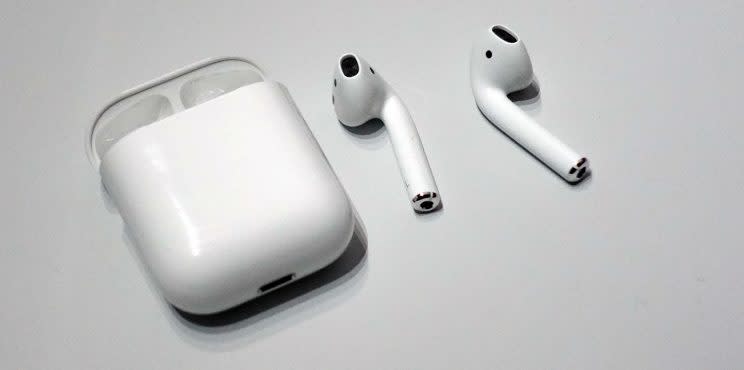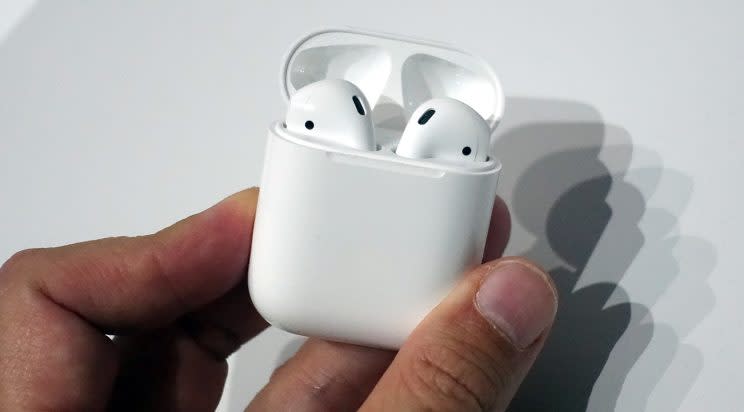Apple Airpods review: You're worrying about the wrong thing
In 2010, when a customer wrote Apple (AAPL) to complain about his iPhone 4 dropping calls, Steve Jobs himself emailed back.
“You’re holding it wrong,” he said. (OK, what he actually wrote was, “Just avoid holding it in that way.” But that’s not quite as much fun.)
This week, after a long delay, Apple’s AirPods finally started shipping. Already, the world is full of complaints about their strange, detached, dental-themed design. But if Steve Jobs were alive today, he might say: “You’re complaining about them wrong.”
The AirPods are pretty great. Their strange design does present some problems—but not the ones everyone’s complaining about.

Meet the AirPods
Starting with the iPhone 7, Apple joined a growing list of phone makers that are eliminating the headphone jack. Yes, Apple includes, in the box, a new pair of wired earbuds (they attach to the charging jack) and an adapter that accommodates existing ones.
But Apple believes that it’s high time we eliminate the cords, the tangles, the knots—and go wireless with our earbuds, the way we’ve gone wireless with just about everything else.
Bluetooth earbuds and headphones are nothing new. In fact, they now outsell wired headphones, at least by dollar volume. But Apple’s earbuds are, as you’d hope, far more elegant and slick than their rivals.
For example, they come in a dental-floss box—I’m sorry, a white carrying case—that doubles as a recharging battery. Fifteen minutes in the case, and you’ve recharged the AirPods for another 3 hours of listening. (The case itself charges over a standard iPhone Lightning cable.)

When fully charged, the AirPods play for 5 hours—10 hours if you listen to only one at a time, Apple points out—and the case holds enough juice to recharge them for 24 hours of listening.
You might scoff at the notion of listening to only one earbud at a time. But in practice, that turns out to be a great way to listen—on the train, on the plane, in a car, on foot—because you can listen to your YouTube videos, phone call, or background music without becoming isolated from your environment.
The Apple Touch
Sweet Apple touches abound in these things.
For example, all you have to do to “pair” a new pair to your iPhone is open the lid of the AirPods case. Within seconds, a picture of the AirPods and the case appears on your phone’s screen, complete with the current battery levels—and a Connect button. They’re now your phone’s voice—and, thanks to Apple iCloud syncing, they’re now also available to play from to your Mac, iPad, and any other gadget you’ve got, with no additional pairing.

(You can use AirPods as normal Bluetooth earbuds with non-Apple equipment, but you lose things like that auto-pairing and some of Apple’s proprietary audio technology.)
This is magic, too: When you take one AirPod out of your ear socket, to answer the flight attendant, for example, your music pauses automatically—and resumes when you put it back into your ear. Yes, there’s an optical sensor in each one that recognizes when it’s in your ear. Very slick.
When a call comes in, your music pauses automatically, and noise cancellation kicks in so your voice is clearer.
A magnetic click holds the AirPods securely in the case, and another magnet holds the case shut. You’ll spend hours snapping it open and closed when you’re on phone calls or waiting for your Uber.
Siri is Her
Nobody really thinks about this, but the AirPods’ ability to connect you to Siri really may be the killer app. You double-tap either AirPod to get an immediate, crisp “I’m listening” chime—and then you talk.
And she speaks her reply, intimately and clearly, right into your brain. (Except when she shows her answer on your phone screen instead of speaking it. That’s such a drag.)
Now you know why the AirPods have that goofy-looking stem pointed at your mouth: It’s to aim their microphones at your voice. Siri’s recognition through the AirPods is incredibly good, no matter how noisy your environment. An AirPod+Siri comes as close as technology yet allows to the in-ear computer made famous in the 2013 movie “Her.” (Tragically, Siri doesn’t yet sound like Scarlett Johansson.)
Do They Fall Out?
The AirPods are shaped exactly like the white, wired, standard EarPods that they replace. If those feel comfortable in your ears, then AirPods will, too, and vice versa.
So let’s put this to rest right now: The AirPods don’t fall out. That would be the ultimate audio dropout. (Thank you, thank you! Tip your waitress.)
They stay in snugly when you’re dancing, bopping, shivering. They stay in under conditions when the wired EarPods would have fallen out. In other words, here’s what most people miss: The weight and tug of the earbud cord add to the falling-out problem, rather than solving it.
So if that’s what you’re worried about, forget it.
What you do have to worry about is dropping the AirPods. They’re tiny and shiny-slick; Apple may as well have covered them with Teflon. In the three months I’ve been testing them, I’ve dropped ‘em a few times onto the floor of the commuter train or the bowels of my airplane seat, simply in the process of transferring them between their two homes: the case and your earholes. (A replacement AirPod costs $70, although of course you could always just forage in couch cushions in public places.)
And I’ll bet you anything that, in crowded cities, AirPod ear pickpocketing will become a thing.
If you’re still freaked out by the notion of two, not-connected earbuds, other Bluetooth wireless earbud designs are available, including two from Apple’s Beats line that have over-hear hooks and other systems that keep the earbuds on when you’re running, exercising, or standing upright.
The Sound and the Fury
These earbuds sound great. Easily as good as the wired EarPods, maybe better. Easily as good as Bluetooth earbuds costing $200 or $250 from other companies—so no, $160 really isn’t a gouging price. Partly that good quality comes from the seal of your ear canal, and partly that’s because of that extra layer of wireless goodness that Apple added on top of the standard Bluetooth signal.
So you don’t need to worry about that, either.
Aside from dropping AirPods as you handle them, the big drawback is this: They have no buttons at all. You can double-tap to answer a call or speak to Siri, but there are no volume controls, no Next/Previous Song buttons. If you want to adjust the volume or skip tracks, you have to use your phone—or speak to Siri (“Make the volume louder” or “Next track,” for example). Neither is always convenient.
So yeah, the AirPods introduce some hassles you didn’t have before. But don’t forget how many hassles they eliminate: Untangling your earbud cord when you pull it from your pocket or bag—every. Single. Time.
Plugging it into your phone. Unplugging it. Getting it snagged on things. Figuring out how to thread it on your winter jacket. Feeling it snap against your neck when you’re jogging. Coiling it up and putting it back when you’re done.
Often, when I’m in a cab or a train, I don’t bother playing Facebook videos people have posted. It’s just not worth the hassle of hauling out and setting up the cords for such a short stint.
But it’s different in the AirPods Era. You open the case, put an AirPod in your ear, and hit Play.
None of Apple’s latest efforts—Apple Watch, MacBook Pro, Apple Music—have been critically acclaimed smash hits. But the AirPods are a different story: Ridiculous amounts of cool technology packed into ridiculously tiny space. It’s nice to see some of the old Apple magic.
David Pogue, tech columnist for Yahoo Finance, welcomes non-toxic comments in the Comments below. On the Web, he’s davidpogue.com. On Twitter, he’s @pogue. On email, he’s poguester@yahoo.com. Here’s how to get his columns by email.
